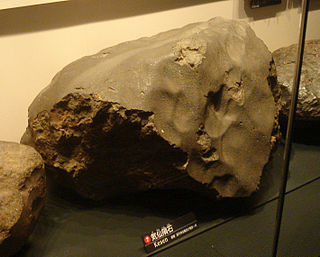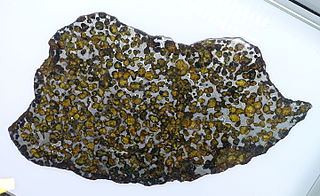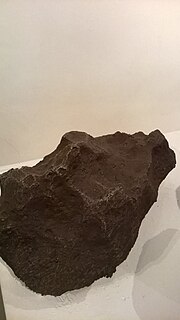| Loreto | |
|---|---|
A photograph of Loreto sent by collector Stuart H. Perry to the Smithsonian Institution. | |
| Type | Iron meteorite |
| Country | Mexico |
| Region | Baja California Sur |
| Observed fall | No |
| Found date | 1896 |
| TKW | 95 kilograms (209 lb) |
The Loreto is a meteorite that was found in Baja California Sur, Mexico. It was found in 1896 and weighed approximately 95 kilograms (209 lb). [1]

A meteorite is a solid piece of debris from an object, such as a comet, asteroid, or meteoroid, that originates in outer space and survives its passage through the atmosphere to reach the surface of a planet or moon. When the object enters the atmosphere, various factors such as friction, pressure, and chemical interactions with the atmospheric gases cause it to heat up and radiate that energy. It then becomes a meteor and forms a fireball, also known as a shooting star or falling star; astronomers call the brightest examples "bolides". Meteorites vary greatly in size. For geologists, a bolide is a meteorite large enough to create an impact crater.

Baja California Sur, officially the Estado Libre y Soberano de Baja California Sur, is the second-smallest Mexican state by population and the 31st admitted state of the 31 states which, with Mexico City, make up the 32 Federal Entities of Mexico.

Mexico, officially the United Mexican States, is a country in the southern portion of North America. It is bordered to the north by the United States; to the south and west by the Pacific Ocean; to the southeast by Guatemala, Belize, and the Caribbean Sea; and to the east by the Gulf of Mexico. Covering almost 2,000,000 square kilometres (770,000 sq mi), the nation is the fifth largest country in the Americas by total area and the 13th largest independent state in the world. With an estimated population of over 120 million people, the country is the eleventh most populous state and the most populous Spanish-speaking state in the world, while being the second most populous nation in Latin America after Brazil. Mexico is a federation comprising 31 states and Mexico City, a special federal entity that is also the capital city and its most populous city. Other metropolises in the state include Guadalajara, Monterrey, Puebla, Toluca, Tijuana and León.
It was donated, by Stuart H. Perry, to the United States National Museum. Today, it resides in the collection of the National Museum of Natural History. [1]

The National Museum of Natural History is a natural history museum administered by the Smithsonian Institution, located on the National Mall in Washington, D.C., United States. It has free admission and is open 364 days a year. In 2016, with 7.1 million visitors, it was the fourth most visited museum in the world and the most visited natural-history museum in the world. Opened in 1910, the museum on the National Mall was one of the first Smithsonian buildings constructed exclusively to hold the national collections and research facilities. The main building has an overall area of 1,500,000 square feet (140,000 m2) with 325,000 square feet (30,200 m2) of exhibition and public space and houses over 1,000 employees.
A small amount of the meteorite was distributed to other organizations, leaving NMNH with 90 kilograms (200 lb). [1]



















